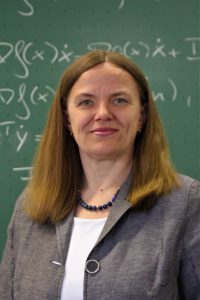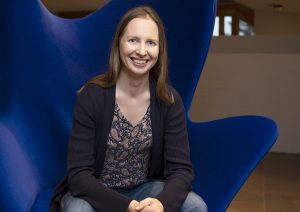
Getting to know our convenors better: double interview with Andrea Walther and Kaie Kubjas
Interview by Francesca Arici and Anna Maria Cherubini
When have you realised you wanted to become a mathematician?

Andrea Walther
A: That’s a pretty long story. I already liked maths at school. However, right after school, I did not have the courage to study maths so I started training as a banker. I realised rather soon that this was not what I wanted to do for the rest of my life. After I finished the training I started to study math and economy. Working on my diploma thesis which was motivated by an applied math project simulating infrared sensors I discovered that research is really great fun. That was definitely the turning point where I realised that working as a research-oriented mathematician would be a great thing to do.
K: It was a very natural process and I never made a conscious decision. In the sixth grade, my mathematics teacher asked me to participate in the regional mathematics olympiad. I won it and from there on it was natural that I would participate in all other mathematics competitions that took place in Estonia. During the rest of the school years, maths, physics and chemistry olympiads were a big part of my life. In the last year of high school, I was also selected to the Estonian team at the international math olympiads. When deciding what to study at the university, I also considered law and computer science for some period, but mathematics was always the first choice.
What do you like the most about being a mathematician?
A: This is difficult to answer since there are several aspects that I enjoy very much: working on a tricky proof and the pleasure when you finally finish it, lively discussions with colleagues and students, as a professor the freedom to work on the mathematical problems that are really of interest to you, and I could probably name a few other points that are almost as important as the ones mentioned before.

Kaie Kubjas
K: At school what fascinated me the most about mathematics was problem-solving. This is the reason why I also wanted to do a PhD: After spending many years solving problems that already had solutions, I wanted to challenge myself to solve unsolved problems. I have to say that back then I did not care much if a problem had an application. This is something that has changed for me since my PhD. Although I still enjoy working on some projects just for the sake of the beauty of mathematics, then I also like to have projects that are more applied.
Another thing that Andrea Walther also mentions is that as a mathematician one has the freedom to work on whatever one likes. I think very few jobs have a similar degree of freedom in choosing what one works on. Finally, I really like working with enthusiastic and motivated students. This is something that gives me lots of energy and it’s great to see the students to find their own paths in mathematics.
What kind of problems are you currently thinking about?
A: Recently we developed a completely new approach to solving nonsmooth optimisation problems. Currently, the algorithm works well for small to medium size problems and the theory covers the unconstrained case. Now, we are on the way to extend the approach and the corresponding theory for a larger problem class with the vision to have a stable implementation that can be used for real-life problems at some point in the future.
K: In the last few years, I have become interested in applications of nonlinear algebra in the life sciences. For example, currently, I’m collaborating on my first neuroscience project, where we analyze manifolds of brain activities. I’m also working on 3-dimensional genome reconstruction, where we study how to infer the 3-dimensional structure of the genome from contact data between chromosomes. The importance of algebra is that it allows answering the question of whether there is a unique reconstruction (up to rigid transformations) given the contact data. If there are infinitely many different reconstructions that give the same contact data, then no algorithm can construct the original one, so it is important to ask the identifiability question first.
Are there any results you are particularly proud of?
A: Quite often you improve an existing result here and there suggesting small changes for improvement. I see the approach for nonsmooth optimisation that Andreas Griewank and myself analysed as something different, as a major step in a new direction. Therefore, this is something I am really passionate about. Furthermore, there is the algorithm that I analysed in my PhD thesis for the memory-reduced calculation of derivative information. It is still used a lot even after such a long time. Therefore, this is also a contribution I am proud of.
K: In a recent work with Robert Krone, we proved so far the strongest necessary condition for the uniqueness of nonnegative matrix factorizations. Nonnegative matrix factorizations are used in many data mining applications (topic modelling, image processing, biology etc) where the factorization gives the decomposition of data by parts. Uniqueness is important for the interpretability of these decompositions. This area has been very active in the last 15 years and I am really proud that we could make our contribution. It was also nice that we could use tools from a completely different field, namely rigidity theory. It was the longest and perhaps the most challenging project that I have worked on. I first started thinking about this problem in 2014 and we finished the preprint in 2019.
When did you first get involved in EWM and how has your experience been so far?
A: I have been aware of EWM for a very long time. For example, I subscribed to the EWM letter for many years. Then I met Carola Schönlieb at the Women in Optimisation workshop at the University of Trier in 2017. She presented EWM and its work in more detail in her talk at the workshop. Since then I have also been a member of EWM to support its idea of encouragement and networking. Since last year in the summer, I am the convenor of EWM. In the past months, I met (unfortunately only virtual) numerous women who support EWM and women in maths in general with incredible energy and enthusiasm. The amount of effort behind EWM with innumerable helping hands is really overwhelming. I am happy to see that there are so many of us.
K: I don’t remember exactly anymore, but I think that I joined EWM in 2013. I was a postdoc at MPI Bonn then and the EWM GM took place in Bonn. But I got sick exactly during the GM and could not attend it. The first time when I heard about EWM was in 2008 when I was a Master’s student in Berlin and Eva Bayer-Fluckiger gave the Kovalevskaya Colloquium. Before the colloquium, female students had the chance to meet her and I remember her talking about EWM. I became the deputy treasurer in 2016, a member of the Standing Committee in 2018 and the deputy convenor in 2020. It has been a great experience to work closely together with Andrea Walther. I have been really amazed by the work and energy that many people put into EWM including the newsletter team, website team, standing committee, the country coordinators and the COVID-19 working group. The open letter on the impact of COVID-19 was in my opinion very important raising the issue and received relatively lots of attention.
What is your vision for the future of EWM as an organisation?
A: Together with Kaie Kubjas, I would like to continue the activities that were initiated by Carola and Elena as former convenors. Furthermore, my goal is to increase the number of nominations of women for distinctions and prices which is related to the provision of an international database of women in mathematics. Finally, given all the online experience that we have now, we aim at an increase of activities within EWM. The successful screening of the movie “Picture a scientist” is already one step in this direction.
K: I hope that with the online tools that we have adopted during the pandemic time, we can organize more central EWM events in addition to the General Meetings and activities during ECM. The GA last summer, the Picture a Scientist panel, and the joint CWM and EWM event have shown that we have now completely new possibilities to organize such meetings. We are also actively working on fundraising so that we can offer more travel grants and hopefully in the future also childcare grants to EWM members.
Any advice for women mathematicians at the beginning of their careers?
A: Do the maths that you enjoy most since this is what you are good at. Furthermore, there are always people that criticise you since it is not possible to please everyone. Nevertheless, believe in yourself!
K: It is important to find one’s own path and not to listen to others too much. I also think that PhD supervisors and mentors play an important role in making one’s life in academia easier. I was given this advice before my PhD and I would like to give it also to others: Having a supportive PhD supervisor is more important than the precise topic. Of course, it is good to have some idea about the direction, but it is also good to have some flexibility. I was also recommended to talk to the current students and postdocs of the prospective supervisor to get an idea if the group would be a good fit.
Text comment...

Leave a Reply
You must be logged in to post a comment.